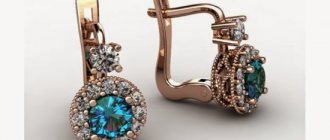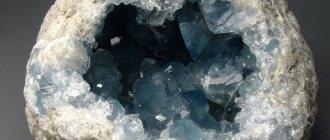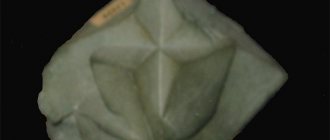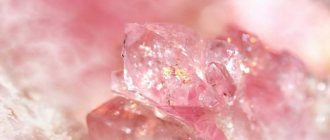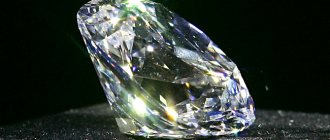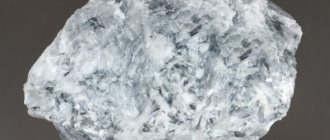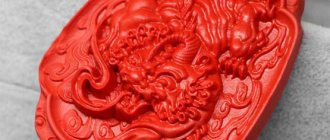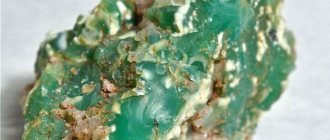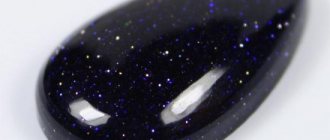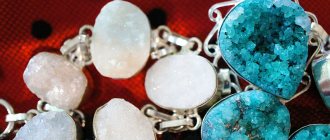During the natural processes of formation of the earth's crust or rock formations, spherical cavities are formed. In scientific language they are called geodes (from the Greek “geoda” - similar to earth).
In mineral mines, the internal cavity of the geode is filled with layers or crystals of gems, for which such formations are valued by jewelers and collectors.
Education mechanism
Most often, geodes form in sedimentary rocks or limestone. This is due to the mechanism of their formation:
- Under the influence of volcanic processes, cracks or cavities of rounded shapes constantly form in the bowels of the earth. The outer wall of such nodules may consist of silica, quartz, chalcedony, agate or chrysoprase.
- The structure is durable, but has small cracks.
- Groundwater flowing through such a cavity leaves a sediment of mineral salts.
- When a high concentration of minerals in the sediment is reached, crystallization begins.
- The large free space of the geode does not prevent the growth of crystals until they completely fill it.
The amethyst geode is especially famous for its beauty, from which both figurines and jewelry are made in Brazil and Uruguay. Due to the largest reserves of amethyst, geodes larger than a man are also found there.
What is a druse
A druse is an accreted aggregate of crystallized minerals (translated from German as “brush”). This name was given for the similarity of the shape of the crystals connected in a chaotic order in the cavity of the sphere with bristles.
The direction of the tops of the stones can also be oriented in one direction, then the nugget looks very impressive.
Even the fusion of just 2 gems together is equivalent to druses, and their size can be no more than a few millimeters.
Types of drusen
Based on the composition of the crystals and the base on which they rest, druses are classified as follows:
- Single-component. The formation of crystals occurs on a mineral of a similar composition. For example, lime spar stones grow on a base of the same spar, which has a granular structure.
- Multicomponent. The crystal is formed by one mineral, and the layer on which it is fixed is formed by another. Thus, quartz druse often forms on gold ore.
View this post on Instagram
Posted by Zhanara Serikkan (@art_serikkan) Jul 25, 2021 at 2:58 PDT
By form:
- Straight when the base has no irregularities.
- Curved, as in spherical cavities.
- A drusen is called a flower when the crystals grow from the center to the periphery of the cavity.
- A brush is a druse made up of small crystals growing in a vertical plane.
The size of a drusen can be either miniature - a few millimeters - or large.
Interesting! The largest druse is more than 2 m high and consists of rock crystal. Such an exhibit is kept in the Mining Museum of St. Petersburg.
When are fakes found?
Among mineral druses, fakes and forgeries made from various decorative materials are often found. To create imitation gemstones, natural stones of a lower order can be used. It is worth looking for differences between a fake and a stone of natural origin in each individual case, depending on the origin and composition of the main mineral.
To begin, hold the druzy in one palm for a few minutes, then transfer it to the other hand. If the surface of the mineral remains cool, synthetic origin can be suspected.
Individual specimens exhibit special characteristics after being illuminated with an ultraviolet lamp or by heating. Such studies and tests are traditionally carried out in laboratory conditions.
Differences between a geode and a druse
In mineralogy, geodes are any cavities in a rock filled with a mineral. The formation of such a formation is called secretion, since most often the gems penetrate into the rock, seeping through the walls along with water.
The mineral components inside the geode can either crystallize or be layered on the walls. The combined pattern of a layered pattern on the walls and crystals in the center looks beautiful.
Unlike druses, geodes are always multicomponent. The cavity itself is formed by the rock due to ruptures, cracks or solidification of gas bubbles. And minerals get inside when the geode comes into contact with groundwater, which brings with it microparticles of gems.
If a mineral crystallizes inside a closed cavity, then the formation will no longer be called a druse, but a geode.
Types of geodes
Geologists distinguish between types of geodes depending on the mechanism of crystallization of minerals:
- Recrystallized geodes. Their peculiarity is that under the influence of changing external conditions, already formed crystals dissolve. This solution is washed with thermal waters to remove excess impurities. Then the drusen begins to crystallize again from the concentrate. As a result, the body of the mineral turns out to be transparent, without suspensions or inclusions.
- Limonite. Formed in iron ore rock. In cavities or cracks, when water enters, oxidative processes occur that form geodes.
- Silica. Found in quartz limestone cavities. Most often it forms a druse - a brush of gemstones.
- Metosomatic geodes. A subject of study for scientists, as they represent the process of replacing one mineral with another inside a cavity.
- Ferromanganese. A promising object of study, as they are located on the ocean floor.
By size, geodes less than 1 cm are distinguished - tonsils.
View this post on Instagram
Publication from Elena Dobrovolskaya (@dobrolen.khv) July 25, 2021 at 12:13 PDT
Drusen of natural minerals: what kind of stones are they and what properties do they have?
Druze
A druse is a unique stone, or more precisely, aggregations of minerals that form some semblance of a conglomerate, reminiscent of a brush. It is “brush” that is the word that means the word “druze”. The stones form aggregates lining the walls and voids, creating something incredibly beautiful and unique. Many geodes are composed of druses; “brushes” can be formed from various rocks, for example, from quartz, garnets, amethysts, calcites, pyrites and other stones.
The shape of the crystal depends on the characteristics of the stones, on growth and environmental conditions. Such joints are rarely sold on the market; they are usually offered in luxury stores and jewelry boutiques, or from the craftsmen themselves. Most often they end up in private collections or on museum shelves.
Brushes are usually small pebbles fused together. Minerals held together by a common base are called flowers. Druses are not created synthetically, therefore the cost of natural conglomerates is quite high; it depends, first of all, on the type of rock.
Appearance
The external characteristics of drusen largely depend on what mineral they are made of. Basically, the aggregates form quartz, and therefore their colors can be completely different, almost the entire color range. Garnet druses are usually red, sapphire druses are blue, and emerald druses are green. If several rocks are combined in a conglomerate, the color range can become even wider and richer. This is the uniqueness and beauty of druzes - they can be different.
The same applies to the parameters of strength and transparency. All these characteristics depend on the properties of the stone forming the druse. The formation of druses occurs in a circle, the crystals gradually fill the cavities from the walls to the center, they can stick out in different directions, and grow chaotically. Some crystals touch each other, some grow separately. The size of the formations can also vary.
Typically, drusen are born red or pink, violet, purple. Less commonly you can find green or yellow aggregates, transparent, black, blue. Many of them have translucent or transparent characteristics.
Treatment
Handling drusen is a complex concept. The beauty of conglomerates lies in their naturalness, natural growth and formation, which is why druses are often not processed. They can be cleaned, polished or ground a little, but all these parameters depend on the specific sample and its constituent rock.
Refining is rarely used for this kind of stones. For example, for druzes, metal spraying (titanium, iron) is periodically used while the stone is heated. A thin layer of the resulting metal is usually applied to corundums in order to give them a certain shade. But sometimes druses also require modification of their external properties. The coating must be handled very carefully, as it can easily be scratched or damaged.
Application
The main use of druses is the decorative side of use. Very often, clusters of stones become beautiful home decor and complement the interior. The conglomerate can be used to decorate a desktop, and also as a magical amulet for the home.
Typically, druses are not sawed or cut, and therefore, if the ornamental sphere is used here, it is only partially, to separate the constituent components of the unit.
In jewelry, there was also a place for beautiful and incredible druzes. They are used to make earrings or pendants, necklaces, mainly units in their original form without processing or refined are used for this.
And, of course, we should not forget about the collection sphere, where druzes are used much more often. Brushes are unique, many of them consist of rare and expensive types of stones, and their formation in nature is not widespread, which is why druses are rarer specimens of stones. This leads to a hunt among collectors for the most unique specimens.
Magic properties
A druse is a symbol of harmony, unity, the same that is formed among stones that calmly coexist next to each other to create something new and whole. But the druse still needs to be considered as a conglomerate of those stones that make up the aggregate, especially if it contains a combination of several rocks. Therefore, brushes are an excellent gift for a married couple; they help keep the home and people’s relationships in balance, and strengthen their union.
In order for a druse to show its strength, it is important to place it in an open place so that all household members can see it, and nothing interferes with its positive vibrations. Stones can bring other benefits to their owner, for example, material well-being. To do this, the unit is placed under the sun's rays during the day, but not for long, and at night it is saturated with the energy of the moon.
Druse is able to absorb negative energy, transform it into positive energy and transmit it to the environment. The same applies to the aura of its bearer. In many ways, the properties of a stone depend on what mineral it is made of. For example, an amethyst druse can attract love, an emerald druse can give willpower, a ruby druse can impart courage and bravery.
Medicinal properties
Stone therapy, first of all, extends to creating harmony in relation to a person. Druse helps you collect your thoughts, clear your mind and put your feelings in order. It calms, eliminates stress and insomnia, and helps fight many nervous and psychological diseases. It is prescribed for the treatment of tics and panic attacks, neuroses, and is recommended for auto-training sessions and meditation.
In many ways, the properties of druse vary depending on the type of mineral from which it is composed. So, for example, an amethyst brush can cure alcoholism, an emerald brush helps with heart and stomach diseases, and a pomegranate brush helps cleanse the blood.
Fakes
Druse can be faked from different types of materials. In particular, stones of a lower order can be used to imitate more precious druses. You need to look for ways to distinguish a fake from a natural stone in each case separately, focusing on the main mineral in the composition of the brush.
You can try holding the druse in one hand for a few minutes, then transfer it to the other palm. If the stone remains cool, this indicates that it is real.
Some druses are composed of hard minerals, for example, emerald. A scratch test will help distinguish it from a fake.
Many stones exhibit special properties after exposure to ultraviolet light or during heating. But such tests are best carried out by a specialist in a laboratory setting.
Care
Caring for druzies depends on the type of stone the brush is made of. But it is always better to immediately determine the place where your product will be stored. This should be a place away from heating devices, open fire, and sunlight. It is advisable to place the druse separately from other items and decorations.
If it is decor, then it needs to be periodically wiped from dust, and also washed with water and mild soap. It is better to take your product to a specialist for deep cleaning.
Shape and color scheme
The color of a geode depends entirely on the composition of the minerals that form it. Layered gems are more often found with alternating red-brown and white-gray layers. The pastel range is represented by blue and pink shades. Geodes with yellow-green citrine, purple amethyst, or smoky quartz are often found.
Important! Too intense coloring of a stone should raise doubts about its authenticity. Sometimes common geodes made of colorless minerals are tinted and passed off as expensive gems.
The spherical shape of geodes is the least common in nature, but it is the one that is most valued. The crystals in it are arranged radially in the form of rays and can consist of celestine, calcite, gypsum or marcasite.
Characteristics
An amethyst druse somewhat resembles a bunch of grapes; the crystals intricately grow together and turn into a cluster of stone. At the same time, it does not require any processing, has a lavender shade, which is so characteristic of amethyst, and for which it has been valued and loved for many years.
Amethyst druse
Crystals fused together rarely have a pink tint. Such druses are quite expensive, they are equated in value to precious stones, although amethyst is a semi-precious stone and is inferior in value to diamonds and sapphires.
Stones attached to the rock have unique properties:
- They tolerate high temperatures well.
- Lose color in water.
- They brighten under the rays of sunlight.
If we talk about real amethysts, and not artificial ones, then they can withstand exposure to high temperatures quite well. You can heat the stone to 200 degrees, it will lighten a little, but after cooling the shade will be restored. If you heat a gem to a temperature of 250 degrees, it will become colorless; The color of the mineral will be partially restored after cooling, but it will not be able to completely return the shade.
If you immerse an amethyst in water, it will become colorless around the edges. In this way, the stone was checked for authenticity hundreds of years ago.
A distinctive feature of the mineral is its ability to change color. Few stones have the chameleon effect; along with amethyst, only alexandrite can boast of similar characteristics.
In the light of the sun, the druse pleases with the iridescence of a purple hue, but in the light of lamps the crystals shine with a delicate pink color.
Extraction and processing
If the extraction of solid stones occurs on an industrial scale, then the discovery of druses often becomes a matter of amateurs. Searchers manually reseed rocks in already explored mines and river soils and rely only on their intuition and experience. Their finds are often small in size, and there are not always already formed druses inside.
View this post on Instagram
Posted by @sally.weis Apr 25, 2021 at 3:51 am PDT
In Russia, quartz geodes have decorative value. They contain agate, chalcedony, amethyst or hematite. Most of them are found in northern Asia and the Urals.
Interesting! In the local dialect of the Urals, geodes are called “znoryshki”. The druses in them most often consist of rock crystal.
The meticulous work of finding geodes is only a small part compared to further processing. The plaque covering the cavity is in most cases removed by long soaking in concentrated acids. Next, you need to be able to saw the geode in the correct place without destroying the tops of the crystals or displacing the center of the cavity.
Where are druses used?
The traditional use for mineral druses is decorating and decorating homes, decorating or preparing establishments for festive events. You can use a sample of mineral origin to decorate your own workplace, and also use it as a magical amulet to protect your home from negative energy.
Druses of natural origin are not cut into pieces or sawn, so this stone is very rarely used for making crafts or decorative works. Minerals are often used in jewelry to make earrings, necklaces or bracelets. Most often, mineral conglomerates are chosen by collectors to add a unique exhibit to their exhibition.
Legends and myths
Over the centuries-old history of gems, their properties have been shrouded in many myths and legends.
Smoky quartz druses were considered the most powerful dark amulet in ancient times. Black magic rituals were carried out after receiving energy from this stone, and oracles used them to look into the future.
View this post on Instagram
Posted by Crown and Diadem (@safinadiadem) Jul 26, 2021 at 2:49 PDT
All Druze, regardless of composition, are credited with the magical property of giving harmony. Symbolically, they are a positive example of the interaction of many individual elements forming a single whole. In the house, such a figurine is placed in the most visible place, purifying energy flows from negativity.
It is believed that charging the mineral with sunlight during the day and moonlight at night can attract wealth into the home. Just remember that ultraviolet rays discolor minerals.
Mystical properties of druzes
The magical properties of druse are determined by its composition.
For example, amethyst druse reduces anxiety, fights depression and loss of strength, frees a person’s thoughts from negativity and cleanses his living space of bad energy.
Agate geodes protect the owner from the influence of enemies, energy vampires. They are chosen if the work involves communicating with a large number of people. Suitable as a talisman for small children.
Crystal druses are considered stronger than a single stone, due to the preservation of their natural shape.
Large geodes concentrate a large amount of energy. It is believed that if you shout your wish into such a cavity, it will definitely come true.
BENEFIT OF QUARTZ IN LITHOTHRAPY
- Quartz has long taken its place in lithotherapy as a time-tested remedy. It is used to enhance intelligence, memory, and muscle tone.
- Quartz druse is especially valued due to its accumulating abilities - several crystals on the same base only enhance each other’s magical properties.
- Druses are especially valued, in which the minerals are directed in one direction - this way the energy of the crystals acts even more efficiently.
Quartz water
- The main property of quartz water is its rejuvenating effect on the entire body.
- The effect is especially noticeable on the skin: regular washing with this water helps smooth out wrinkles, heal abrasions and burns.
- To prepare quartz water, you need to infuse the water with clear quartz or its colored varieties.
Quartz sticks
- Long crystals are called quartz rods.
- They are of both natural origin and artificial, when they take shape after appropriate processing.
- They are used to enhance and concentrate energy flows in the places to which they are applied.
- Massage with such sticks allows you to restore your energy field and relax your body muscles.
We recommend: All about the Aventurine stone
Quartz balls
- Spherical quartz is the main tool in the hands of an experienced magician or occultist.
- Balls are used to train the subconscious, enhance the abilities of the “third eye”, and open up new boundaries of energetic possibilities.
- Fortune tellers see the past and future in the spheres.
- When meditating, the balls help clear your thoughts about the body from vice.
Quartz crystals
Quartz, due to its shape and color, has unique abilities:
| Patterned crystals |
|
| Generator crystals |
|
| Rainbow crystals |
|
Laser quartz
- Quartz is called laser if it has a wide base that tapers towards its end.
- Experienced magicians know how to use a mineral of a similar structure to direct energy flows.
- The energy scattered in ordinary crystals is collected in laser quartz into a beam of colossal power.
- It is important to trust only experienced magicians to work with such crystals.
- Without special knowledge, you should not point the crystal at other people - this will harm both the owner of the mineral and his counterpart.
Quartz Phantoms
- Quartz phantoms are a great helper even for those who do not have any abilities in lithotherapy.
- Small pyramids are visible at the base of the minerals, which also make it possible to determine the age of the mineral.
- Phantoms help in exercises with your own subconscious - if you focus on them and keep the image of phantoms in your head.
- Images help to find powerful clues on the path of life.
- The path that phantoms take in the human brain serves as a key to deeper levels of the subconscious. A person sees himself from a different angle, and with due persistence, he completely changes himself.
- Experts advise using only phantoms with a correct, even structure - any defect will negatively affect the experience of using the crystal.
We recommend: Luck's Favorite GREEN AVENTURINE
Charms and jewelry made from druzes and geodes
Geodes with semi-precious stone crystals are used by jewelers to make jewelry. Large nuggets are valuable to collectors, and the largest specimens are displayed as exhibits in mineralogy museums.
Jewelry made from natural stone druses is valued for the natural shape of the crystals, so the processing of such a find is very careful. They are only framed in metal to make jewelry. Tonsils (geodes less than 1 cm) are first sawn in half.
Video about the magical and healing properties of mineral geodes:
Precious geodes
Not all geodes attract collectors and jewelers, but only those filled with gem crystals. They end up in museums, private collections and jewelry workshops, where they are used to make original jewelry. Geodes with amethyst crystals are most prized.
Large specimens - caves - remain in the area where they were mined as a natural attraction. Thus, in museums in Uruguay and Brazil you can see geodes that can comfortably fit an adult. They create such interesting compositions from them:
In Russia, geodes with agate, chalcedony, hematite, and amethyst are most often found; they look quite beautiful both in jewelry and in various compositions. In the Urals, geodes are called “gnarly”; here, specimens with rock crystal inside are most often found.
In Africa and Asia there are geodes with celestite, in the Alps - with calcite crystals. In the USA - with azurite.
Geodes are not only mined industrially; unusual gifts of nature are hunted by amateurs for whom communication with nature and collecting crystals is an exciting hobby that can bring considerable income. In Russia, a small geode measuring 5-7 cm with gray agate costs about 3 thousand rubles.
They check old workings and small abandoned mines using hand tools. Often luck really smiles on them, and lovers find geodes with multi-colored citrines, amethysts, rauch topazes, and rock crystal.

